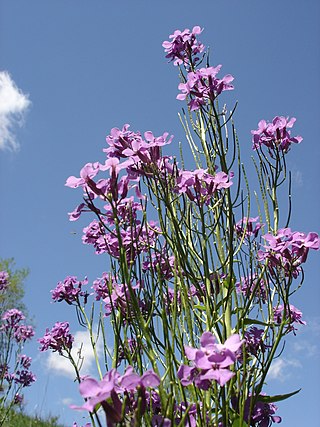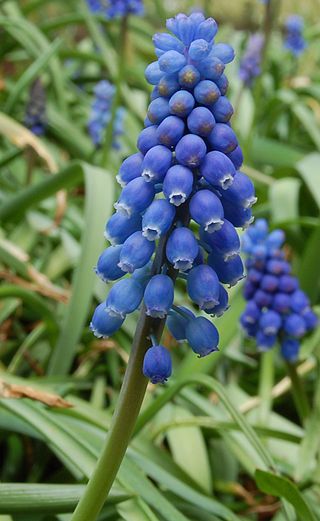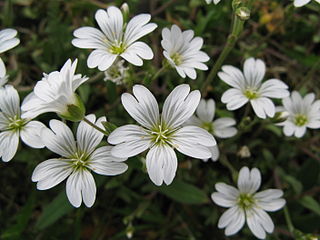
Bellis is a genus of flowering plants in the family Asteraceae.

Cytisus is a genus of flowering plants in the family Fabaceae, native to open sites in Europe, western Asia and North Africa. It belongs to the subfamily Faboideae, and is one of several genera in the tribe Genisteae which are commonly called brooms. They are shrubs producing masses of brightly coloured, pea-like flowers, often highly fragrant. Members of the segregate genera Calicotome, Chamaecytisus, and Lembotropis are sometimes included in Cytisus.

Genista is a genus of flowering plants in the legume family Fabaceae, native to open habitats such as moorland and pasture in Europe and western Asia. They include species commonly called broom, though the term may also refer to other genera, including Cytisus and Chamaecytisus. Brooms in other genera are sometimes considered synonymous with Genista: Echinospartum, Retama, Spartium, Stauracanthus, and Ulex.

Knautia is a genus of flowering plants in the family Caprifoliaceae. It includes 55 species native to Europe, North Africa, Western and Central Asia, and Siberia. The common names are variants of "widow flower". Others are given the name "scabious", which properly belongs to the related genus (Scabiosa). The name Knautia comes from the 17th-century German botanists, Drs. Christoph and Christian Knaut.

Linaria is a genus of almost 200 species of flowering plants, one of several related groups commonly called toadflax. They are annuals and herbaceous perennials, and the largest genus in the Antirrhineae tribe of the plantain family Plantaginaceae.

Hesperis is a genus of flowering plants in the family Brassicaceae. Most are native to Eurasia, with several endemic to Greece and Turkey. Many plants of this genus bear showy, fragrant flowers in shades of purple and white. One of the more widely known species is the common garden flower Hesperis matronalis. The genus name Hesperis was probably given because the scent of the flowers becomes more conspicuous towards evening.

Muscari is a genus of perennial bulbous plants native to Eurasia that produce spikes of dense, most commonly blue, urn-shaped flowers resembling bunches of grapes in the spring. The common name for the genus is grape hyacinth, but they should not be confused with hyacinths. A number of species of Muscari are used as ornamental garden plants.

Isatis is a genus of flowering plants in the family Brassicaceae, native to the Mediterranean region east to central Asia. Its genus name, Isatis, derives from the ancient Greek word for the plant, ἰσάτις. The genus includes woad. Due to their extremely variable morphology, the Asian species in particular are difficult to determine; the only reliable diagnostic feature is the ripe fruit. They are (usually) biennial or perennial herbaceous plants, often bluish and hairless or downy hairy with the upright stem branched.

Cerastium is a genus of annual, winter annual, or perennial flowering plants belonging to the family Caryophyllaceae. They are commonly called mouse-ears or mouse-ear chickweeds. There are 214 accepted species, found nearly worldwide but with the greatest concentration in the northern temperate regions. A number of the species are common weeds in fields and on disturbed ground.

Arenaria is a genus of flowering plants, within the family Caryophyllaceae.

Scilla luciliae is a species of flowering plant in the family Asparagaceae. It is referred to by the common names Bossier's glory-of-the-snow or Lucile's glory-of-the-snow, and is a bulbous perennial from western Turkey that flowers in early spring. After flowering, it goes into dormancy until the next spring. The specific epithet is in honour of Lucile, the wife of the Swiss botanist Pierre Edmond Boissier (1810-1885). It belongs to a group of Scilla species that were formerly put in a separate genus, Chionodoxa, and may now be treated as Scilla sect. Chionodoxa.

Anthyllis is a genus of flowering plants in the family Fabaceae. This genus contains both herbaceous and shrubby species and is distributed in Europe, the Middle East and North Africa. The most widespread and familiar species is A. vulneraria, a familiar grassland flower which has also been introduced to New Zealand.

Erodium is a genus of flowering plants in the botanical family Geraniaceae. The genus includes about 60 species, native to North Africa, Indomalaya, the Middle East, and Australia. They are perennials, annuals, or subshrubs, with five-petalled flowers in shades of white, pink, and purple, that strongly resemble the better-known Geranium (cranesbill). Cultivated plants are known as filarees or heron's bill in North America, whereas in the British Isles they are usually called storksbills.

Anthemideae is a tribe of flowering plants in the family, Asteraceae, and the subfamily Asteroideae. They are distributed worldwide with concentrations in central Asia, the Mediterranean Basin, and southern Africa. Most species of plant known as chamomile belong to genera of this tribe.

Asyneuma is a genus of flowering plants in the bellflower family, Campanulaceae. They are native to North Africa and Eurasia. Many are endemic to Turkey. Plants of the genus may be known commonly as harebells, but this name can also apply to the entire family. There are up to about 33 species.

The Antirrhineae are one of the 12 tribes of the family Plantaginaceae. It contains the toadflax relatives, such as snapdragons.

Chaenorhinum minus, also known as small toadflax in Europe and dwarf snapdragon in the US and Canada, is a very diminutive member of the plant family Plantaginaceae. It is native to continental Europe.

Prangos is a genus of flowering plants of the family Apiaceae, native from Europe to Mongolia and the western Himalayas.


















